A year does not have to begin anew after 12
months. There were several other options and for instance
was the Phoenix cycle around 18 months (or 'years'):
...
A sidelight falls
upon the notions connected with the stag by Horapollo's
statement concerning the Egyptian writing of 'A long space
of time: A Stag's horns grow out each year. A picture of
them means a long space of time.'
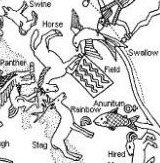
Chairemon
(hieroglyph no. 15, quoted by Tzetzes) made it shorter: eniautos:
elaphos.
Louis Keimer,
stressing the absence of stags in Egypt, pointed to the Oryx
(Capra Nubiana) as the appropriate 'ersatz', whose
head was, indeed, used for writing the word rnp =
year, eventually in 'the Lord of the Year', a well-known
title of Ptah.

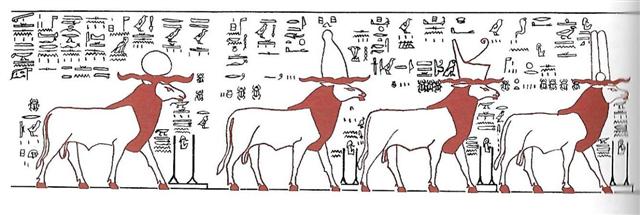
(E - S - N - W)
Rare as this
modus of writing the word seems to have been - the
Wörterbuch der Aegyptischen Sprache (eds. Erman and
Grapow), vol. 2, pp. 429-33, does not even mention this
variant - it is worth considering (as in every subject dealt
with by Keimer), the more so as Chairemon continues his list
by offering as number 16: 'eniautos: phoinix', i.e.,
a different span of time, the much-discussed
'Phoenix-period' (ca. 500 years).
There are
numerous Egyptian words for 'the year', and the same goes
for other ancient languages. Thus we propose to understand
eniautos as the particular cycle belonging to the
respective character under discussion: the mere word
eniautos ('in itself', en heauto; Plato's
Cratylus 410D) does not say more that just this.
It seems
unjustifiable to render the word as 'the year' as is
done regularly nowadays, for the simple reason that there is
no such thing as the year; to begin with, there is
the tropical year and sidereal year, neither of them being
of the same length as the Sothic year. Actually, the methods
of Maya, Chinese, and Indian time reckoning should teach us
to take much greater care of the words we use. The Indians,
for instance, reckoned with five different sorts of 'year',
among which one of 378 days, for which A. Weber did not have
any explanation. That number of days, however, represents
the synodical revolution of Saturn. Nothing is gained by the
violence with which the Ancient Egyptian astronomical system
is forced into the presupposed primitive frame.

The eniautos
of the Phoenix would be the said 500 (or 540) years; we do
not know yet the stag's own timetable: his 'year' should
be either 378 days or 30 years, but there are many more
possible periods to be considered than we dream of - Timaios
told us as much. For the time being the only important point
is to become fully aware of the plurality of 'years', and to
keep an eye open for more information about the particular
'year of the stag' (or the Oryx), as well as for other
eniautio, especially those occurring in Greek myths
which are, supposedly, so familiar to us, to mention only
the assumed eight years of Apollo's indenture after having
slain Python (Plutarch, De defectu oraculorum, ch.
21, 421C), or that 'one eternal year (aidion
eniauton)',
said to be '8 years (okto
ete)',
that Cadmus served Ares
...

The 2nd half of the Celtic year began in
July:
... Midsummer is
the flowering season of the oak, which is the tree of
endurance and triumph, and like the ash is said to 'court
the lightning flash'. Its roots are believed to extend as
deep underground as its branches rise in the air - Virgil
mentions this - which makes it emblematic of a god whose law
runs both in Heaven and in the Underworld ... The month,
which takes its name from Juppiter the oak-god, begins on
June 10th and ends of July 7th. Midway comes St. John's Day,
June 24th, the day on which the oak-king was sacrificially
burned alive. The Celtic year was divided into two halves
with the second half beginning in July, apparently after a
seven-day wake, or funeral feast, in the oak-king's honour
...
Possibly: 3 * 118 + 7
= 361 = 19 * 19 = 7 + 2 * 177.
But if the Phoenix (bird on fire) cycle was 540 days = 1½ * 360
days, then the end of his 'year' could be in January rather
than in July. The Birth of First Mother was 540 days after
the Birth of First Father:
|
Defeat of
Seven Macaw |
May 28, 3149 B.C. |
12.18.4.5.0 1 Ahaw 3 K'ank'in |
|
Birth of First Father |
June 16, 3122 B.C. |
12.19.11.13.0 1 Ahaw 8 Muwan |
|
Birth of First Mother |
December 7, 3121 B.C. |
12.19.13.4.0 8 Ahaw 18 Tz'ek |
|
Creation |
August 13, 3114 B.C. |
4 Ahaw 8
Kumk'u |
|
Ahau.
To blow freshly, coolness, zephyr, salubrious,
breeze, wind; ahau ora, agreeable breeze. Hau,
to blow, blusterous, to breathe. |

hau
ia
Ba2-11 |
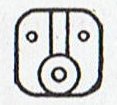
Ahau (Ahaw) |
Such an
eniautos
(540)
would result in jumping from a beginning in July to a
beginning in January and then back again in a regular
pattern, from Cancer to the Capricorn and then back
again to
Cancer.
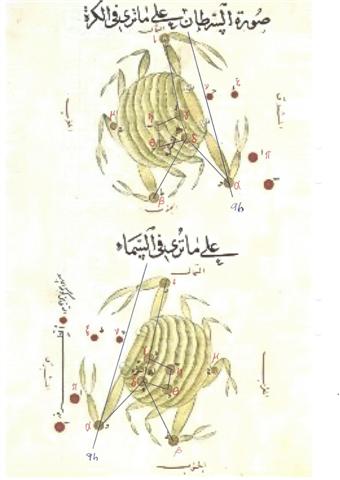
... Far
away, the Mangaians of old (Austral Islands, Polynesia),
who kept the precessional clock running instead of
switching over to 'signs', claim that only at the
evening of the solstitial days can spirits enter heaven,
the inhabitants of the northern parts of the island at
one solstice, the dwellers in the south at the other
...
What can we read in the G text regarding
"December 7? Given that First Mother was a female we
maybe should look for the day when the Full Moon was
at "December 7 (Ko Koró 7)?
And we have been here before. December 7
is the first day beyond number 260 (= 20 * 13), and 261
equals
9 * 29 where 29 signifies the dark rebirth night of the Moon
(when the Sun was at her back):
... When the
new moon appeared women assembled and bewailed those who
had died since the last one, uttering the following
lament: 'Alas! O moon! Thou has returned to life, but
our departed beloved ones have not. Thou has bathed in
the waiora a Tane, and had thy life renewed, but
there is no fount to restore life to our departed ones.
Alas ...
|
8
MAY (*48) |
9 |
10
(130) |
11 |
12 |
13 |
|
*MAY
10 |
11 |
12
(*52) |
13 |
14 |
15
(135) |
|
MAY 14 (*54) |
15 |
16 (136) |
17 |
18 |
19 |
 |
 |
 |
 |
 |
 |
|
Ga2-24 |
Ga2-25 |
Ga2-26 |
Ga2-27 |
Ga2-28 |
Ga2-29 (59) |
|
φ
Gemini
(118.4) |
DRUS
= χ Carinae (119.9) |
ω
Cancri (120.2) |
8h
(121.7)
χ
Gemini
(121.0),
NAOS
= ζ Puppis
(121.3) |
ρ Puppis (122.0),
HEAP
OF FUEL
= μ Cancri (122.1), ζ Monocerotis (122.3), ψ
Cancri (122.6),
REGOR (Roger reversed)
= γ Velorum (122.7) |
TEGMINE (Covered Up) = ζ Cancri
(123.3) |
|
July
17 |
18 |
19
(200) |
20
(*121) |
21 |
22 /
7 |
|
"June 6 (157) |
7 |
Kaulua
3 |
9
(*80) |
Maro 10 |
11 |
|
ι Sagittarii
(301.2), TEREBELLUM
= ω Sagittarii, ξ Aquilae (301.3),
ALSHAIN (Falcon)
= β Aquilae (301.6), φ Aquilae (301.8) |
ε Pavonis, θ
Sagittarii (302.3), γ Sagittae (302.5), μ
Pavonis (302.7) |
τ Aquilae (303.8) |
20h (304.4)
η Sagittae
(304.2), δ Pavonis (304.4) |
SHANG WEI (Higher
Guard) = κ Cephei (305.2), θ Sagittae
(305.4),
TSEEN FOO (Heavenly Raft) =
θ Aquilae (Ant.) (305.6), ξ Capricorni (305.8) |
TSO KE (Left Flag)
= ρ Aquilae (306.3) |
|
January 16 |
17 |
18 (383) |
19 |
20 |
21 |
|
"December 6 |
7 (9 * 29) |
8 |
Ko Koró 9 (*263) |
10 |
11 |
|
NOVEMBER 13 |
14 |
15 |
16
(320) |
17 |
18 (*242) |
|
*NOVEMBER 9 |
10
(314) |
11 |
12
(*236) |
13 |
14 |
|
7
NOVEMBER |
8 |
9 |
10
(314) |
11 |
12
(*236) |
|
14 MAY |
15 |
16 (136) |
17 |
18 (*58) |
|
*MAY 16 (136) |
17 |
18 |
19 |
20 (*60) |
|
MAY 20
(140) |
21 |
22 |
23 |
(*64 =
*128 / 2) |
 |
 |
 |
 |
 |
|
Ga3-1 |
Ga3-2 |
Ga3-3 |
Ga3-4 (63) |
Ga3-5 |
|
AL TARF (The End)
= β Cancri (124.3)
RAS ALGETHI (α Herculis)
|
χ Cancri (125.2),
BRIGHT FIRE
= λ Cancri (125.4) |
AVIOR
= ε Carinae (126.4), φ Cancri (126.8) |
ο Ursa Majoris (127.4) |
Pushya-8
υ Cancri (128.1),
θ CANCRI
(128.2) |
|
July 23 (204) |
24 (*125) |
25 |
26 |
27 (208) |
|
°July 19 (200) |
20 (*121) |
21 |
22 / 7 |
23 (204) |
|
'June 26
(177) |
27 |
28 |
29 (*100) |
SIRIUS |
|
"June 12 (163) |
Kaulua 8
(*84) |
14 (165) |
Maro 15 |
Kaulua 11 |
|
GREDI
(Goat) = α Capricorni
(307.2), σ Capricorni (307.5),
ALSHAT (The Sheep -
to be slaughtered) = ν Capricorni
(307.9) |
Al Sa’d al
Dhabih-20 (The Lucky One of the
Slaughterers) /
Ox / Herd Boy-9
(Buffalo)
DABIH =
β Capricorni (308.0), κ Sagittarii (308.1),
SADIR
(Breast)
= γ Cygni (308.4),
PEACOCK = α Pavonis
(308.7) |
KHUFU
MINTAKA (δ Orionis)
|
KHAFRE
ALNILAM (ε Orionis)
|
MENKAURE
ALNILAK (ζ Orionis)
|
|
OKUL = π
Capricorni (309.6),
BOS = ρ Capricorni (309.9)
ARNEB (α Leporis)
|
ο Capricorni
(310.2), θ CEPHEI (310.5)
HEKA (λ Orionis)
|
ROTTEN MELON
= ε Delphini, φ Pavonis (311.2), η
Delphini (311.4), ζ Delphini, ρ Pavonis
(311.7)
PHAKT (α Columbae)
|
|
January 22 (387) |
23 |
24 (*309) |
25 (390) |
26 |
|
°January 18
(384) |
19 |
20 (385) |
21 (*306) |
22 |
|
'December 26 (360) |
27 |
28 |
29 (363) |
30 (*284) |
|
"December 12 |
Hilinama
8 (*266) |
14 (348) |
15 |
Ko Koró
16 (*270) |
|
NOVEMBER 19 |
20 (316) |
21 |
22 (*246) |
23 |
|
*NOVEMBER 15 |
16 (320) |
17 |
18 (*242) |
19 |
|
13 NOVEMBER |
14 (318) |
15 |
16 (*240) |
17 |
| Hiri
1. To braid, plait, tress
(hair, threads). 2. To rise in coils (of
smoke). 3. To hover (of birds). Vanaga. 1.
To elevate, to mount. Hiriga, to
elevate; elevation, mounted, ascension,
assumption, declivity; hiriga
mouga, hillside. Hirihiri, a
swing, seesaw. P. Pau.: iri, to be
put up in a place, to lodge. Mgv.: iri,
placed in a higher position than the
observer, as a box on a high shelf. Ta.:
iri, to lodge or stick up in a place.
The germ signification is 'above, higher'.
In Samoa it is used most commonly in a
tropical sense, but the primal sense is
sufficiently retained in the signification
to lodge, to stick in, to show general
concord with Rapanui and particular harmony
with the other languages of Southeast
Polynesia. 2. To make a bag; taura hiri,
to make a cord; rauoho hiri, plaited
hair; hirihiri, frizzed; rauoho
hirihiri, lock of hair. P Mgv.: hiri,
wo weave, to plait; akahiri, to make
a mat. Mq.: hii, large plait of
coconut fiber. Ta.: firi, to plait,
to braid. When we interpret in the sense of
local conditions Père Roussel's definition
'to make a bag' the concord is perfect, for
bags are woven. The germ sense is plainly
the act of twining in and out, over and
under, which, with specific differences due
to manner and material, may result in
plaiting or weaving; see hiro. 3. To go, to
walk, to voyage, to arrive, to appear;
hiri tê reka, to go without noise;
hiri koroiti, to go softly; hiri
tahaga no mai, to go without a halt.
Hiriga, voyage, journey; hiriga
hakapa, to go by twos; hiriga hipa,
to go obliquely; hiriga kokekoke, to
go by sudden steps; hiriga okorua, to
go by twos; hiriga tahataha to go
across; hiriga tekiteki, to go on
hopping; hiriga tê mataku, to go on
fearlessly; hiriga totoro, to go on
all fours; hiriga varikapau; to go in
a ring; hiriga veveveve, to go
boldly. Churchill.
Pau.: Hirinaki. 1.
To incline, to slope. Ta.: hirinai,
to rest upon. Ma.: irinaki, to rest
upon. 2. To be apprehensive. Ta.: hirinai,
to apprehend. Churchill. Mgv.: Aka-hiria,
to enquire after. Sa.: sili, to ask,
to demand. Hirihiri, to fish for
turtle. Mq.: fiifiii, a small net for
taking turtle. Churchill. |
| HILI,
v. Haw., to braid, plait, twist, turn
over, spin; wili, id.; wili,
s. a ribbon a roll; wili-wili, to
stir round, to mix; another dialectical
variation is hilo, to twist, turn,
spin. Sam., fili, to plait, as
sinnet; filo, to mix, s. twine,
thread; vili, a gimlet, a whirlpool.
Marqu., fau-fii,
twist, braid. N. Zeal., wiri, id.
Rarot., iro, id. Tah., firi,
id.; hiro, id. Fiji., siri,
askew, not nicely in a row, wrong, in error.
Tagal and Bisays, hilig, a woof.
Greek, είλω,
to roll up, to press together, pass to and
fro, to wind, turn round;
έλισσω,
turn round or about, roll, whirl;
έλιξ,
adj.,
twisted, curled; s.
anything of a spiral shape, twist, curl,
coil; ίλλω,
to roll, of the eyes, to squint, look
askance; ίλλος,
squinting; ίλλας,
a rope, band; ίλιγξ,
a whirlpool.
Sanskr., vel,
vehl,
to shake, tremble;
vellita,
crooked;
anu-vellita,
a bandage. To this Sanskrit
vel
Benfey refers the Greek
είλω,
the Latin volvo,
and the Gothic
walojan.
Liddell and Scott also incline to connect
είλω
and
volvo
with the same root. To me it would seem as
if the Sanskrit
vrij,
whose 'original signification', Benfey says,
is 'to bend', and the Sanskrit
vrit,
whose 'original signification', Benfey says,
is 'to turn', were nearer akin to the
primary form from which the Greek
είλω,
ίλλω, and
the Polynesian hili,
wiri,
descend: that primary form being
vri, now
lost to the Sanskrit, with a primary sense
of to bend, twist, turn over, braid, and of
which vel,
vell,
or vehl,
is possibly another secondary and attenuated
form. With such a Sanskrit vŗi.
surviving in vŗij
and vŗit,
the derivation of the Latin filum,
thread, as twisted, spun; of the Latin
varus,
bent asunder, parting from each other,
varix,
crookedness; of the Saxon wile,
deceit; of the Swedish willa,
confusion, error, wilse,
astray, becomes easy and intelligible.
(Fornander) |
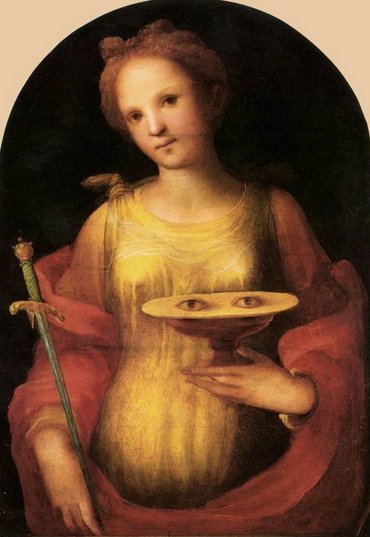
There were 100 days from "June 12
(163) to "December 9 (263), from heliacal Al Tarf
(the End) to the night when Naos (ζ Puppis) could be
seen close to the Full Moon.
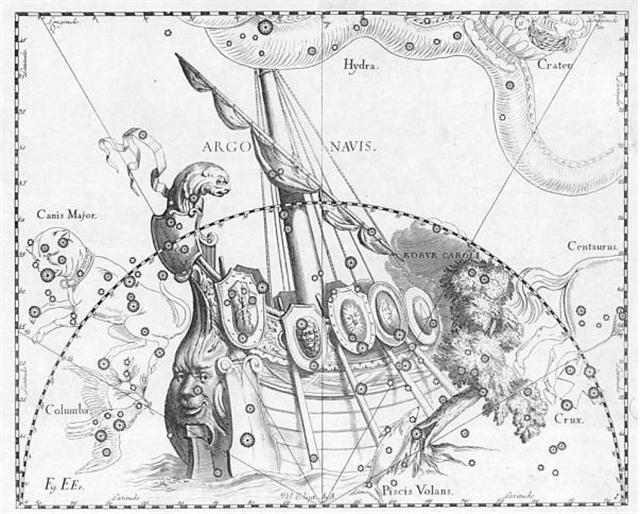
The Easter Island month name for
"December was Ko Koró which ought to mean the month of
the Feast:
| Kokoro
Width, expanse; wide, spacious. Te kokoro o te hare, the expanse
of a wide house. Vanaga.
To widen, to expand. Churchill. |
| Koro 1. Father (seems to be an older word than matu'a
tamâroa). 2. Feast, festival; this is the generic term for feasts
featuring songs and banquetting; koro hakaopo, feast where men
and women danced. 3. When (also: ana koro); ana koro oho au ki
Anakena, when I go to Anakena; in case, koro haga e îa,
in case he wants it. Vanaga. If. Korokoro, To clack the tongue (kurukuru).
Churchill.
Ma.: aokoro, pukoro, a halo around the
moon. Vi.: virikoro, a circle around the moon. There is a
complete accord from Efaté through Viti to Polynesia in the main use of
this stem and in the particular use which is set to itself apart. In
Efaté koro answers equally well for fence and for halo. In the
marked advance which characterizes social life in Viti and among the
Maori the need has been felt of qualifying koro in some
distinctive manner when its reference is celestial. In Viti virimbai
has the meaning of putting up a fence (mbai fence); viri
does not appear independently in this use, but it is undoubtedly
homogenetic with Samoan vili, which has a basic meaning of going
around; virikoro then signifies the ring-fence-that-goes-around,
sc. the moon. In the Maori, aokoro is the cloud-fence. Churchill
2. |
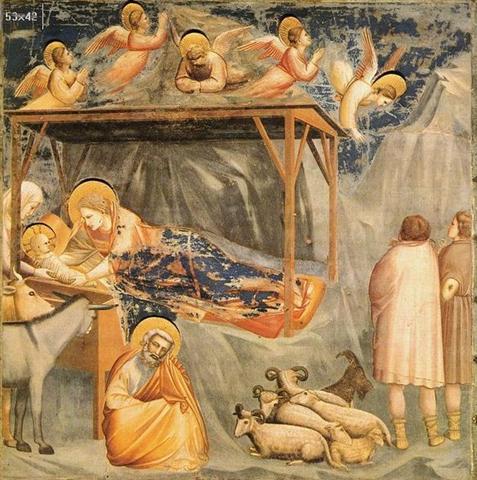
And at the other side of the equator, on
Hawaii, they could have regarded the month Taku-lua
on the other side of the year
as a month for feasting:
... three
lines are drawn east and west, one across the northern
section indicates the northern limit of the Sun
(corresponding with the Tropic of Cancer) about the 15th
and 16th days of the month Kaulua (i.e., the 21st
or 22nd of June) and is called ke alanui polohiwa a
Kane, the black-shining road of Kane. The
line across the southern section indicates the southern
limit of the Sun about the 15th or 16th days of the
month Hilinama (December 22) and is called ke
alanui polohiwa a Kanaloa, the black-shining road of
Kanaloa. The line exactly around the middle of
the sphere is called ke alanui a ke ku'uku'u, the
road of the spider, and also ke alanui i ka Piko a
Wakea, the way to the navel of Wakea (the
Sky-father)
...
|
Taku
Prediction, prophecy, prognostic,
to predict;
tagata taku, wizard. P Ta.:
tau,
to invoke, to pray.
Takurua, full of stones, pebbly,
stony, a path among the rocks. Churchill. Samoa:
ta'u,
to tell, to mention, to announce, to certify, to
acknowledge. Tonga:
taku, to call by, to designate;
takua,
to mention, to call by name.
Rapanui;
taku,
to predict. Maori:
takutaku, to threaten, to recite
imprecations. Fotuna:
no-tukua,
to confess. Viti:
tukuna, to report, to tell.
Churchill 2.
At
the risk of invoking the criticism, 'Astronomers
rush in where philologists fear to tread', I
should like to suggest that Taku-rua
corresponds with the two-headed Roman god Janus
who, on the first of January, looks back upon
the old year with one head and forward to the
new year with the other, and who is god of the
threshold of the home as well as of the year...
There is probably a play on words in takurua
- it has been said that Polynesian phrases
usually invoke a double meaning, a common and an
esoteric one. Taku means 'slow', the
'back' of anything, 'rim' and 'command'. Rua
is a 'pit', 'two' or 'double'. Hence takurua
has been translated 'double command', 'double
rim', and 'rim of the pit', by different
authorities. Taku-pae is the Maori word
for 'threshold'... Several Tuamotuan and Society
Islands planet names begin with the word
Takurua or Ta'urua which Henry
translated Great Festivity and which is the name
for the bright star Sirius in both New Zealand
and Hawaii. The planet names, therefore,
represent the final stage in the evolution of
takurua which was probably first applied to
the winter solstice, then to Sirius which is the
most conspicious object in the evening sky of
December and January, and was then finally
employed for the brilliant and conspicious
planets which outshone even the brightest star
Sirius. From its association with the ceremonies
of the new year and the winter solstice,
takurua also aquired the meaning 'holiday'
or 'festivity'. Makemson. |
... In between the flowers and the fruits
there was a high summer man on fire:
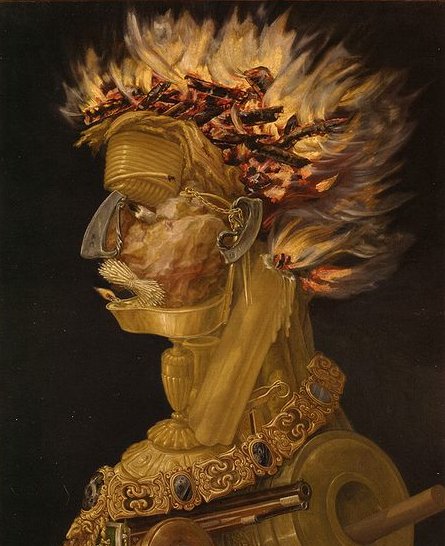
...
The bereaved and sorrowing Isis, meanwhile, wandering over the world in her
quest - like Demeter in search of the lost Persephone - came to Byblos, where
she learned of the wonderful tree. And, placing herself by a well of the city,
in mourning, veiled and in humble guise - again like Demeter - she spoke to none
until there approached the well the handmaidens of the queen, whom she greeted
kindly. Braiding their hair, she breathed upon them such a wondrous perfume that
when they returned and Astarte saw and smelt the braids she sent for the
stranger, took her into the house, and made her the nurse of her child. The
great goddess gave the infant her finger instead of breast to suck and at night,
having placed him in a fire to burn away all that was mortal, flew in the form
of a swallow around the pillar, mournfully chirping. But the child's mother,
Queen Astarte, happening in upon this scene, shrieked when she spied her little
son resting in the flames and thereby deprived him of the priceless boon.
Whereupon Isis, revealing her true nature, begged for the pillar and, removing
the sarcophagus, fell upon it with a cry of grief so loud that the queen's child
died on the spot. Sorrowing, then, the two women placed Osiris's coffer on a
boat, and when the goddess Isis was alone with it at sea, she opened the chest
and, laying her face on the face of her brother, kissed him and wept
...
The flames from a fire went in the
opposite direction compared to the direction of the always downwards (to the
Underworld) flowing waters of life. Immortality could thereforre be reached by
following the flames upwards. This pair of different futures was illustrated by
Vindemiatrix (ε
Virginis, Star Man of Fire, Kakkab Mulu Izi) respectively by Spica (where
Sadalmelik, α
Aquarii) culminated at midnight):

|
62 |
20
JULY (201) |
21 |
22
(22 / 7) |
23 |
24
(*125) |
|
*JULY
22 (22 / 7) |
23 |
24
(*125) |
25 |
26 |
|
JULY 26 |
27 |
28 |
29
(210) |
30
(*131) |
 |
 |
 |
 |
 |
|
Ga5-17 |
Ga5-18 (128) |
Ga5-19 |
Ga5-20 |
Ga5-21 |
|
Al Áwwā'-11 /
Shur-mahrū-shirū-18
(Front or West Shur?)
Sombrero Galaxy = M104
Virginis (191.1), ρ Virginis (191.4),
PORRIMA = γ Virginis,
γ Centauri (191.5) |
ι Crucis (192.2), β
Muscae (192.5),
MIMOSA = β Crucis
(192.9) |
no star listed (193) |
κ Crucis (194.4), ψ
Virginis (194.5), μ Crucis, λ Crucis (194.6),
ALIOTH (Fat Taíl)
= ε Ursae Majoris, ι
Oct. (194.8) |
MINELAUVA
= δ Virginis (195.1),
COR
CAROLI = α Canum
Ven. (195.3) |
|
September 28 |
29 (*192) |
30 (273) |
October 1 |
2 |
|
°September 24 |
25
(*188) |
26 |
27 (270) |
28 |
|
'September 1 |
2 (*165) |
3 |
4 |
5 (248) |
|
"August 18 (*150) |
Hora Iti 19 (231) |
20 |
21 |
22 |
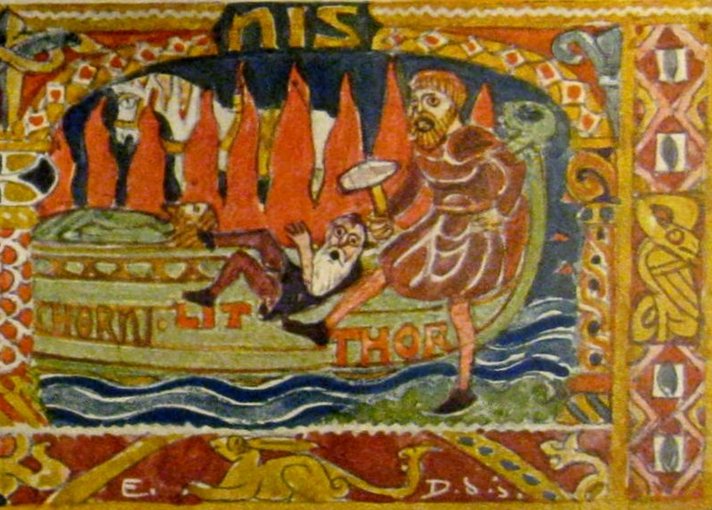
... According to Gylfaginning,
following the murder of Baldr by Loki, the other gods brought his body down
to the sea and laid him to rest on the ship. They would have launched it out
into the water and kindled a funeral pyre for Baldr but were unable to move
the great vessel without the help of the giantess
Hyrrokkin,
who was sent for out of Jötunheim. She then flung the ship so violently down
the rollers at the first push that flames appeared and the earth trembled,
much to the annoyance of Thor. Along with Baldr, his wife Nanna was also
borne to the funeral pyre after she had died of grief. As Thor was
consecrating the fire with his hammer Mjolnir, a dwarf named Litr began
cavorting at his feet. Thor then kicked him into the flames and the dwarf
was burned up as well
...
|




















